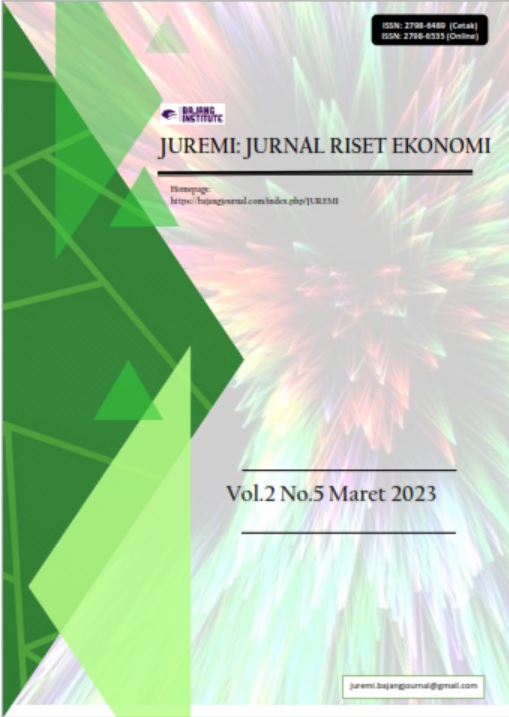KETAKUTAN, PERAN INVESTOR INSTITUSI DAN PERILAKU HERDING DALAM FASE PANDEMI COVID 19
DOI:
https://doi.org/10.53625/juremi.v2i5.5182Keywords:
Herding, Fear, Institutional Ownership, Rolling WindowsAbstract
This study aims to examine the effect between fear of death caused by the covid 19 virus and institutional ownership on herding behavior in companies listed on the LQ45 index (JSII) in the period from 2019 to 2021. The fear variable with the GFI index is a variable that has never been used before by previous studies to be a variable that can estimate whether fear can affect herding behavior. The sample of this study is companies listed on the LQ45 Index on the IDX from 2019 to 2021. The analysis method used is multiple linear regression assisted by Eviews in data processing. The results showed that the fear associated with the global mortality index was able to influence the occurrence of herding behavior on the LQ45 index. Meanwhile, the role of institutional ownership in companies on the IDX is unable to influence the occurrence of herding behavior. This study also proved that at the end of the year and the beginning of 2020 (honeymoon phase) using rolling window regression. It is proved that there has been a herding behavior caused by the fear of investors.
References
Ambarita, GD, Sutadi, T., & Rubiyatno, R. (2018). HERDING BEHAVIOR BASED ON INVESTOR TYPE IN SHARE OWNERSHIP Case Study on Stock LQ-45 Period September 2014–August 2017. EXERO: Journal of Research in Business and Economics, 1(1), 44–67. https://doi.org/10.24071/exero.2018.0110103
Bohl, M. T., Branger, N., & Trede, M. (2017). The case for herding is stronger than you think. Journal of Banking and Finance, 85, 30–40. https://doi.org/10.1016/j.jbankfin.2017.08.006
Brodocianu, M., & Stoica, O. (2017). Herding Behavior of Institutional Investors in Romania. An Empirical Analysis. Review of Economic and Business Studies, 10(2), 115–130. https://doi.org/10.1515/rebs-2017-0057
Bui, N. D., Nguyen, L. T. B., & Nguyen, N. T. T. (2015). Herd behaviour in Southeast Asian stock markets - An empirical investigation. Acta Oeconomica, 65(3), 413–429. https://doi.org/10.1556/032.65.2015.3.4
Chang, C. L., McAleer, M., & Wang, Y. A. (2020). Herding behaviour in energy stock markets during the Global Financial Crisis, SARS, and ongoing COVID-19*. Renewable and Sustainable Energy Reviews, 134. https://doi.org/10.1016/j.rser.2020.110349
Chen, LH, Huang, W., & Jiang, GJ (2017). Herding on Earnings News: The Role of Institutional Investors in Post–Earnings-Announcement Drift. Journal of Accounting, Auditing & Finance, 32(4), 536–560.https://doi.org/10.1177/0148558x17705039
Choi, N., & Sias, R. W. (2009). Institutional industry herding. Journal of Financial Economics, 94(3), 469–491. https://doi.org/10.1016/j.jfineco.2008.12.009
Elster, J. (1998). Emotions and Economic Theory. Journal of Economic Literature, 36(1), 47-74. Retrieved April 21, 2021, from http://www.jstor.org/stable/2564951
Hsieh, M. F., Yang, T. Y., Yang, Y. T., & Lee, J. S. (2011). Evidence of herding and positive feedback trading for mutual funds in emerging Asian countries. Quantitative Finance, 11(3), 423–435. https://doi.org/10.1080/14697688.2010.506882
Kahneman, D., & Tversky, A. (1979). An analysis of decisions under risk. Econometrica, 47(2), 263–292.
Kumar, S., & Goyal, N. (2015). Behavioural biases in investment decision making – a systematic literature review. Qualitative Research in Financial Markets, 7(1), 88–108. https://doi.org/10.1108/QRFM-07-2014-0022
Liao, T.-L., Huang, C.-J., Wu, C.-W., 2011. Do Fund Managers Herd to Counter Investor Sentiment? J. Bus. Res. 64, 207–212.
Luu, Q. T., & Luong, H. T. T. (2020). Herding behavior in emerging and frontier stock markets during pandemic influenza panics. Journal of Asian Finance, Economics and Business, 7(9), 147–158. https://doi.org/10.13106/JAFEB.2020.VOL7.NO9.147
Peterson, R. (2007). Affect and financial decision-making: How neuroscience can inform market participants. Journal of Behavioral Finance, 8(2), 1-9.
Salisu, A. A., Sikiru, A. A., & Vo, X. V. (2020). Pandemics and the emerging stock markets. Borsa Istanbul Review, 20, S40–S48. https://doi.org/10.1016/j.bir.2020.11.004
Sarwar, G. (2012). Is VIX an investor fear gauge in BRIC equity markets? Journal of Multinational Financial Management, 22(3), 55–65. https://doi.org/10.1016/j.mulfin.2012.01.003
Soydemir, G., Verma, R., & Wagner, A. (2017). The asymmetric impact of rational and irrational components of fear index on S&P 500 index returns. Review of Behavioral Finance, 9(3), 278–291. https://doi.org/10.1108/RBF-05-2016-0025
Stein, J. C., & Scharfstein, D. (1990). Herd Behavior and Investment. In American Economic Review (Vol. 80, Issue 3, pp. 465–479).
Zajonc, R. B. (1980). Feeling and thinking: Preferences need no inferences. American Psychologist, 35(2), 151–175. https://doi.org/10.1037/0003-066X.35.2.151
Castleman, Kenneth R., 2004, Digital Image Processing, Vol. 1, Ed.2, Prentice Hall, New Jersey.
















